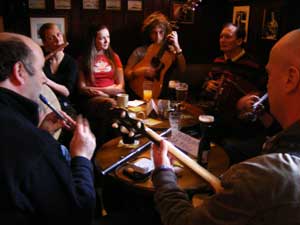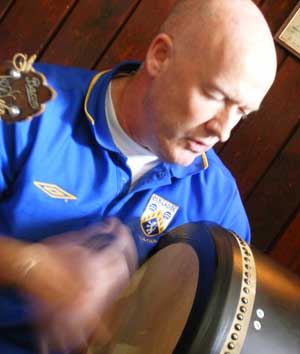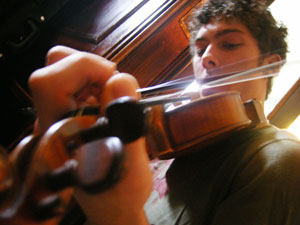Irish Session rules


Since the first day I started Irelandlogue I have been blogging about Irish music sessions.
At least twice a week I attend a live Irish music session and post an mp3 and photo from the session. Regular readers of Irelandlogue.com will be familiar with The Shack, Sean’s Sunday session, Brideswell, Flannery’s, Shine’s, The Green Olive, The Bounty and even Bar Metro.
If you’re visiting the Irish midlands you should definitely stop in to The Brideswell Session for trad on a Thursday and stick the head into Flannery’s to hear some songs on a Friday. Between those, you should get a picture of what a real Irish session is like.
Most of the sessions I attend are traditional Irish music sessions, although most will allow bluegrass and popular music for the occasional song. The Shack is the exception, being an almost entirely modern music session.
For the unindoctrinated, here are some basic rules for attending an Irish music session:
 The first thing you should know is Irish sessions are not a performance in the traditional sense, they are more of a social gathering. Concerts are things performed on a stage facing one’s audience; Irish sessions are not a concert.
The first thing you should know is Irish sessions are not a performance in the traditional sense, they are more of a social gathering. Concerts are things performed on a stage facing one’s audience; Irish sessions are not a concert.
Irish musicians sit in a circle facing each other at their sessions. The idea is that those in the circle have been invited to be there and are focused on each other and the music they’re making. If it pleases those nearby, all the better! But the musicians only hope is that the music they’re all focused on in the midst of themselves will burn as bright and clear as possible, spreading a bit of craíc and joy out into the world. How that world responds is entirely out of their hands – their job is done amongst themselves.
Understanding this, it’s also easy to understand that all the musicians in the circle know the same tunes. This is not amateur hour, an open mic or a jam session; if a member of the circle does not know how to play the tune, he or she simply does not play. Most sessions have a leader or core players who dictate the flow of the session. It may not seem like it sometimes, but if you watch a session you’ll see that the players will usually take their cue from the same place. If you wish to participate, so should you.
 Irish music is focused on the melody. In a reversal of other types of music, Irish rhythm instruments provide variation to back the melody, not the other way around. Therefore rhythm instruments are almost never doubled. One guitar, bouzouki, spoons/bones or bodhrán to a session, please! Imagine in a rock and roll song if two lead guitarists started playing different solos over each other – it’d sound awful! Same thing with rhythm in Irish music – two guitarists playing different backing rhythms or different chords at the same time is going to sound terrible.
Irish music is focused on the melody. In a reversal of other types of music, Irish rhythm instruments provide variation to back the melody, not the other way around. Therefore rhythm instruments are almost never doubled. One guitar, bouzouki, spoons/bones or bodhrán to a session, please! Imagine in a rock and roll song if two lead guitarists started playing different solos over each other – it’d sound awful! Same thing with rhythm in Irish music – two guitarists playing different backing rhythms or different chords at the same time is going to sound terrible.
On the other hand, there is almost no limit to the number of melody players. You will often find many fiddles, flutes, whistles, banjos, mandolins and other instruments playing simultaneous melody. This is why there is little or no “jam” aspect, all the melody players must be in sync. There is also very rarely a “solo” except by very skilled players in familiar sessions where such a thing is anticipated by all involved.
Irish sessions often play a few tunes and then a invite a vocalist to sing a “song.” The ratio of tunes to songs is usually something like 4 to 1. The rules of participation are somewhat relaxed for songs, but the overall rule of subtlety in an Irish session still applies – never overpower the melody. Most human voices cannot compete with the volume of multiple instruments, so take care not to overwhelm the poor singer!
 Finally, if you are a visitor and wish to participate in an Irish session, your best best is to be courteous and listen to see if the session is welcome to participants. Most Irish people are pretty relaxed and glad to see visitors in their neck of the woods. In rural Ireland, you the visitor may be asked to “give us a song” even if you display no outward signs of being musical.
Finally, if you are a visitor and wish to participate in an Irish session, your best best is to be courteous and listen to see if the session is welcome to participants. Most Irish people are pretty relaxed and glad to see visitors in their neck of the woods. In rural Ireland, you the visitor may be asked to “give us a song” even if you display no outward signs of being musical.
Along these lines, there is no reason as a foreigner to feel you must sing an Irish song just because it’s an Irish session. If you’re from the states, sing an American song. If you’re French, sing a French song. Polish? That’s great. Mexican? They’d love to hear that, I guarantee it. You’ll get a hugely favourable response if, when invited to sing, you produce some local song from your homeland.
Not all Irish sessions are traditional. Some traditional sessions are more strict than others. Most sessions around the midlands are pretty open to just about anything, and a few are almost entirely focused on singing and modern music. The basic two rules for any Irish sesion are as follows:
1. Wait for some sort of an invitation lest you intrude on a session.
2. Be subtle; never overpower the melody.